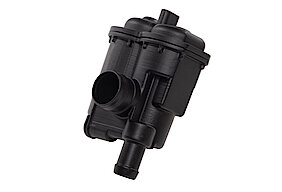Standards that have already applied to cars in Asia and the USA for some years is also essential for new cars if they have a unit on board that can identify leaks in the fuel system. This, together with a corresponding driver warning, is designed to prevent cars from emitting potentially harmful fuel vapors into the environment. The active Tank Leak Monitoring System (TLMS) from Swoboda can perform this function efficiently, accurately, reliably and robustly. “This is true in equal measure for the use of the TLMS in gasoline and hybrid engine cars, as well as in certain fuel cell applications”, explains Florian Wahl, Head of Actuator Development at Swoboda.
Tenfold efficiency increase boosts function and measuring precision
The TLMS allows for a quick automatic tightness check. The system – consisting of an advanced air pump and a solenoid valve – firstly seals off the tank system or its vent from the atmosphere. The diaphragm pump then sets to work with a fan efficiency of up to ten times higher than conventional systems. Once a defined excess pressure level – typically 50 millibar – is reached, the pumps switches off. Pressure monitoring can now take place with the valve still closed. To do this, the system uses the existing tank sensor; alternatively, a pressure sensor can be integrated into the TLMS. Finally, the electronic system calculates whether a leak is present using pressure curve analysis. This means the Swoboda system can detect the smallest of leaks – from 0.5 to 1 millimeter and larger – in the tank or pipes. It can even determine the exact size of the leak and detect faulty gas caps. At the end of the check, the valve opens once again and the tank system is vented cleanly via the existing activated carbon filter. The TLMS is typically installed between the activated carbon filter and a air filter to the atmosphere. Function management and evaluation of the sensor data are usually carried out via the combustion engine's control device.
TLMS performs in nearly all conditions
Despite this, extremely high performance values alone are not enough when it comes to challenging automotive applications. It is also essential to be able to rely on consistent performance under almost all environmental conditions and temperatures. As such, the TLMS from Swoboda enables accurate diagnosis in freezing conditions (-15°C), as well as in intense heat (over 80°C). In addition, it makes no difference to the measurement whether the vehicle is located at sea level or in the mountains, at an altitude of 2,500 meters. The system can even negotiate temperature fluctuations, humidity and dirt. As a result, it notches up additional benefits when measured against competitors' designs: “When you compare our membrane pump with vane pumps, it excels in its robustness and efficiency. And if you contrast the TLMS with other solutions that, for example, infer leaks from the weight of the pump motor, our system offers clear advantages”, Wahl explains.
The use of the TLMS will come on stream from 2025 in production models for a leading global car manufacturer. As early as 2027, Swoboda is estimating an annual production of around 1.4 million units of its advanced system, which can reliably detect almost any leak in a tank.

